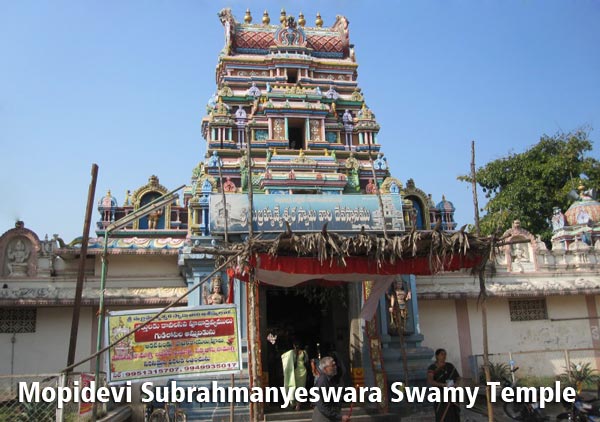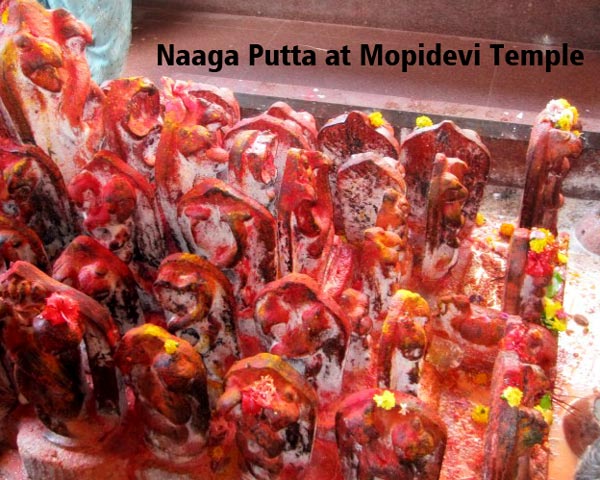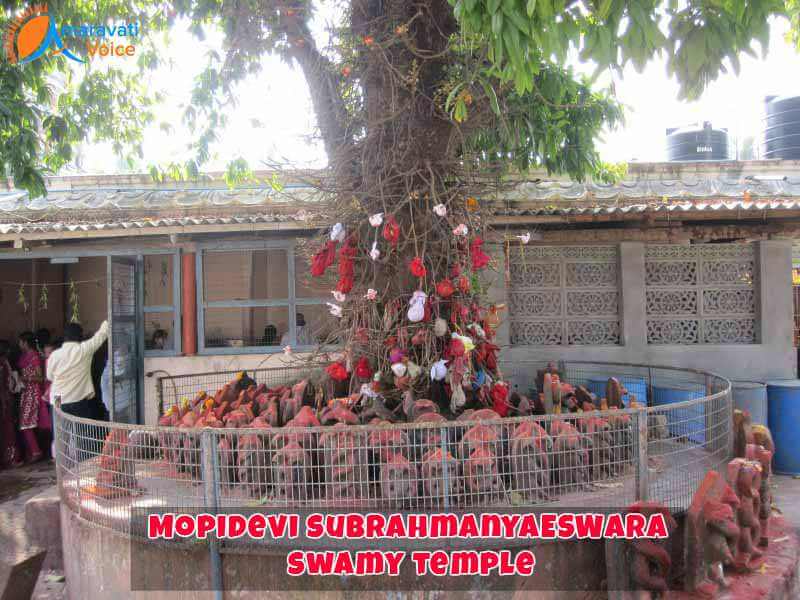 Natives suffering from Sarpa dosha, Rahu, Ketu dosha and Anapathya dosha, if they worship Lord Subrahmanyeswar at Mopidevi will definitely nullify the negative affects according to texts. The Mopidevi temple is situated at a distance of nearly 70 kms from Vijayawada in Andhra Pradesh. It is well connected by flights and trains from many parts of the country.
Natives suffering from Sarpa dosha, Rahu, Ketu dosha and Anapathya dosha, if they worship Lord Subrahmanyeswar at Mopidevi will definitely nullify the negative affects according to texts. The Mopidevi temple is situated at a distance of nearly 70 kms from Vijayawada in Andhra Pradesh. It is well connected by flights and trains from many parts of the country.
Four Deva rishis viz., Sankara, Sanakasa, Sanatkumara, Sanatsujata are known for their un-wavering devotion and saintly knowledge. They are immoral and always appear at the age of five years to others. They remained so detached from the awareness of worldly matters that they remain naked without covering their bodies. Once, they came to Kailash, the above of Lord Shiva to worship Him. At the same time, Sachi Devi, Swaha Devi, Goddess Saraswathi and Goddess Lakshmi also arrived. Lord Subrahmanyeswar was sitting in the lap of his mother Goddess Parvathi by that time. Lord Subrahmanyeswar as a child was bewildered at the two contrasts of fully clad gods and goddesses on the one hand and the nude Deva rishis on the other, he giggled innocently in a childish way. Goddess Parvathi chided Lord Subrahmanyeswar for his folly. Later, Lord Subrahmanyeswar realized his lapse and took permission to do penance to get rid of the blemish. Lord Subrahmanyeswar did the penance in disguise, in the form of a snake for many years and successfully cleansed Himself of the folly. The place where Lord Subrahmanyeswar did penance later became popular as Mopidevi.  According to holy texts, Vindhya mountain at one time became over confident of its strength and began to grow upwards. It went up to the planet Ravi. With this, darkness surmounted all over and all mortals and immortals including every flora and fauna suffered in darkness. Gods prayed to Sage Agasthya to humble the Vindhya mountain somehow or the other. Sage Agasthya is known to have attained divine powers through severe penance. He was staying in Varanasi at that time. He, accepting the request of Devas, Sage Agasthya started towards the mountain Vindhya from Northern India. Vidhya mountain is the boarder between North India and South India. Knowing in advance about the arrival of Sage Agasthya, the Vindhya mountain humbled himself to the lowest level so as to give way to the sage. While crossing the Vindhya mountain, Sage Agasthya took promise from Vindhya to be in that humbled state, till he returns from his tour of Southern India. Bud the sage did not return. He settled in South India only. Waiting ages together, Vidhya mountain remained humbled even today. Sage Agasthya along with his retinue had the occasion to pass through the place, where Lord Subrahmanyeswar did severe penance. He identified the place and said that this area is covered by Tigers and from here if we go towards the Eastern direction, one can find the divine temple of Lord Kumaraswamy known as Subrahmanyeswar. By visiting this temple with devotion, one can get earning all through the life and also attain salvation. It is pertinent to note that the presiding deity of Vijayawada Kanaka Durga rides on Tiger.
According to holy texts, Vindhya mountain at one time became over confident of its strength and began to grow upwards. It went up to the planet Ravi. With this, darkness surmounted all over and all mortals and immortals including every flora and fauna suffered in darkness. Gods prayed to Sage Agasthya to humble the Vindhya mountain somehow or the other. Sage Agasthya is known to have attained divine powers through severe penance. He was staying in Varanasi at that time. He, accepting the request of Devas, Sage Agasthya started towards the mountain Vindhya from Northern India. Vidhya mountain is the boarder between North India and South India. Knowing in advance about the arrival of Sage Agasthya, the Vindhya mountain humbled himself to the lowest level so as to give way to the sage. While crossing the Vindhya mountain, Sage Agasthya took promise from Vindhya to be in that humbled state, till he returns from his tour of Southern India. Bud the sage did not return. He settled in South India only. Waiting ages together, Vidhya mountain remained humbled even today. Sage Agasthya along with his retinue had the occasion to pass through the place, where Lord Subrahmanyeswar did severe penance. He identified the place and said that this area is covered by Tigers and from here if we go towards the Eastern direction, one can find the divine temple of Lord Kumaraswamy known as Subrahmanyeswar. By visiting this temple with devotion, one can get earning all through the life and also attain salvation. It is pertinent to note that the presiding deity of Vijayawada Kanaka Durga rides on Tiger.
 Lord Subrahmanyeswar is the son of Lord Shiva and Goddess Parvathi. While Lord Subrahmanyeswar was in her womb, Goddess Parvati could not bear the power of the foetus and hence transferred the same to Ganga Devi. Ganga also could not bear the power of the foetus and hence the foetus slipped into the reed grass. Six female minor deities called Krittika took care of the embryo. Imbibing the strengths of both Lord Shiva and Goddess Parvati, Lord Subrahmanyeswar was born in the the month of Margasiramasam on Shashti day of waxing Moon with six heads, twelve hands, lot of brilliance, luster and the radiance of Sun. Devotees specially worship Lord Subrahmanyeswar on the days of Ashada Sukla Panchami, Naga Panchami, Nagaula Chaviti and Shashti. Pujas for Rahu and Ketu are performed regularly at Mopidevi Temple. Devotees get tonsured as part of fulfillment of their vow. Some get children's ears bored to get relief from Sarpa Dosha. Females who wants children make a crade with a new Saree to the sacred tree here. People who want to get married soon offer Pongal made of rice and jaggery. People suffering from poor sight, ear ailments, skin diseases, lack of progeny due to previous births' misdeeds etc., get relief by worshiping Lord Subrahmanyeswar in Mopidevi. In particular, natives suffering from Sarpa dosha, Rahu-Ketu dosha and Anapathya Dosha worship of Mopidevi Subrahmanyeswar will be highly beneficial.
Lord Subrahmanyeswar is the son of Lord Shiva and Goddess Parvathi. While Lord Subrahmanyeswar was in her womb, Goddess Parvati could not bear the power of the foetus and hence transferred the same to Ganga Devi. Ganga also could not bear the power of the foetus and hence the foetus slipped into the reed grass. Six female minor deities called Krittika took care of the embryo. Imbibing the strengths of both Lord Shiva and Goddess Parvati, Lord Subrahmanyeswar was born in the the month of Margasiramasam on Shashti day of waxing Moon with six heads, twelve hands, lot of brilliance, luster and the radiance of Sun. Devotees specially worship Lord Subrahmanyeswar on the days of Ashada Sukla Panchami, Naga Panchami, Nagaula Chaviti and Shashti. Pujas for Rahu and Ketu are performed regularly at Mopidevi Temple. Devotees get tonsured as part of fulfillment of their vow. Some get children's ears bored to get relief from Sarpa Dosha. Females who wants children make a crade with a new Saree to the sacred tree here. People who want to get married soon offer Pongal made of rice and jaggery. People suffering from poor sight, ear ailments, skin diseases, lack of progeny due to previous births' misdeeds etc., get relief by worshiping Lord Subrahmanyeswar in Mopidevi. In particular, natives suffering from Sarpa dosha, Rahu-Ketu dosha and Anapathya Dosha worship of Mopidevi Subrahmanyeswar will be highly beneficial.